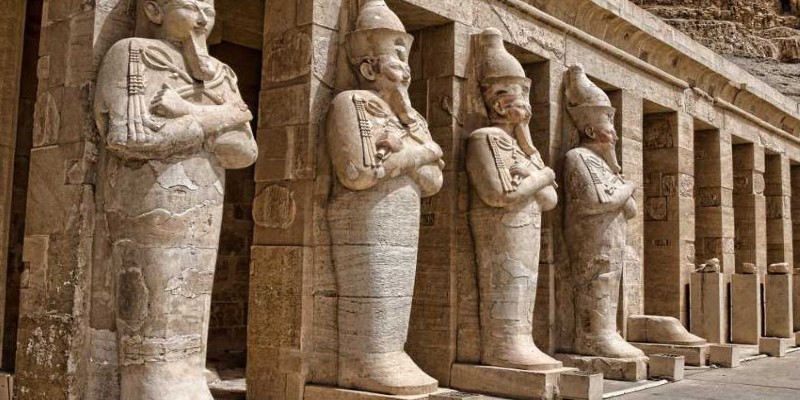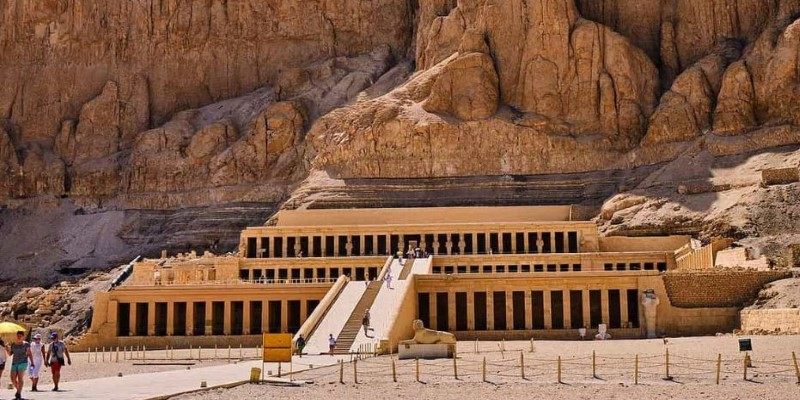The Queen Hatshepsut Temple is one of the most impressive examples of ancient Egyptian architecture, standing nestled against the rugged cliffs of the Theban Mountains in Luxor, Egypt. This temple is dedicated to one of Egypt's most powerful yet controversial pharaohs, Queen Hatshepsut, offering visitors a chance to step back in time and marvel at the grandeur of a civilization long gone. Its unique design and stunning location, coupled with the abundance of history attached to its walls, make visiting Queen Hatshepsut Temple truly unforgettable for anyone traveling to Luxor or simply looking into ancient sites in Egypt. Compared with most other temples of Egypt, Queen Hatshepsut Temple is an excellent architectural work of art perfectly married to the surrounding landscape, which is very striking visually. Its position on the cliff tops makes it a stunning and awe-inspiring view. Its scale and beauty surely leave an impression on every visitor.
The History and Significance of Queen Hatshepsut Temple
Queen Hatshepsut is one of the most intriguing personalities in ancient Egyptian history. She ruled during the 18th Dynasty around 1479-1458 BC. One of the few women who attained the title of pharaoh, her achievements included tremendous trade, architecture, and military conquests during her reign. However, despite her great achievements, Hatshepsut's successor, Thutmose III, erased her legacy, and thus, her reign in the history of Egypt was downplayed.
The temple itself, officially known as the "Djeser-Djeseru" or "Holy of Holies," was erected to glorify the gods and to commemorate her reign. Unlike other temples, it was not constructed in a valley or along a river but rather on a natural limestone cliff at Deir el-Bahari. This architectural wonder temple was constructed on three terraced levels linked with long ramps and consisted of a long row of magnificent colonnades, along which lie statues decorating the entrance. The building is structured so that man-made objects fit perfectly into nature and complement the landscape of mountains.
Hatshepsut's temple is not only a place of worship but also a declaration of her authority and the legacy she hoped to leave behind. The walls of the temple are covered with very detailed reliefs, showing scenes from her life, such as her divine birth and the famous expedition to Punt, which brought back valuable resources to Egypt. There are also images of her as a male pharaoh in the temple, which was an important practice at the time of establishing her legitimacy as ruler.
How to Visit Queen Hatshepsut Temple?
Visiting Queen Hatshepsut Temple is an unforgettable experience that allows you to connect with one of the most powerful female figures in ancient history. Heres everything you need to know to make the most of your visit to this stunning site.
Location and Access
The Queen Hatshepsut Temple is located on the west bank of the Nile in Luxor, close to the Valley of the Kings and the Temple of Karnak. Most tourists arriving at Luxor use local means, such as taxis or guided tours, to visit the temple. It's within easy reach from the main road, and signs direct you to the entrance. If you are taking a guided tour, they would usually take care of everything for you, but if you are traveling independently, you might want to use a taxi or private car to get there for convenience.

The temple's entrance is at the foot of the cliffs. Visitors can climb the ramp to reach the high level or take a ride on one of the local camels, especially recommended for an authentic taste of tradition. The temple is open all year round. The best times to visit are during the morning and afternoon when it's cooler and the crowds are fewer.
Exploring the Temple
Once you enter the temple, you'll be struck by its grand scale and dramatic design. The first thing you'll notice is the impressive colonnade of statues and the grand entrance leading up to the first terrace. The walls are decorated with vivid reliefs depicting scenes from Hatshepsut's reign, including her famous expedition to Punt, which is one of the most well-known parts of the temple's story.
As you ascend the terraces, you'll pass through various halls, each with its historical significance. On the second and third terraces, you'll find more reliefs, including depictions of Hatshepsut's divine birth and her relationship with the gods. The temple's architectural features, such as its long corridors, grand columns, and symmetrical design, all reflect the skills of the ancient Egyptian builders who created this marvel.
The uppermost terrace offers stunning views of the surrounding valley and mountains, making it a great spot for photography. From here, you can appreciate the scale and grandeur of the temple as it blends into the natural landscape and takes in the quiet beauty of the surrounding area.
Tips for Visiting
To make the most of your visit, its helpful to plan and consider a few practical tips:
Time of Visit: The temple can get crowded, especially during peak tourist seasons. To avoid the crowds, aim to visit early in the morning or later in the afternoon when the site is quieter and the temperatures are more manageable.
Guided Tours: While the temple is impressive on its own, having a guide can greatly enhance your visit. A knowledgeable guide can explain the significance of the reliefs, the temples history, and the fascinating life of Queen Hatshepsut, helping you gain a deeper understanding of this ancient site.
Wear Comfortable Shoes: The terrain around the temple can be uneven, especially on the ramps and the terraces. Wear sturdy, comfortable shoes to ensure you can navigate the site without difficulty.

Bring Water and Protection from the Sun: The desert heat can be intense, especially in the summer months. Bring plenty of water, wear sunscreen, and dont forget a hat or sunglasses to protect yourself from the sun.
Conclusion
Visiting Queen Hatshepsut Temple in Luxor is not just a journey through ancient Egyptian history but an opportunity to witness one of the greatest achievements in ancient architecture. The temple's unique location, impressive design, and fascinating history make it a must-see site for anyone visiting Luxor or exploring Egypt's rich past. As you stand before the temple, surrounded by towering cliffs and ancient reliefs, you'll get a sense of the power and ambition of a woman who defied tradition to rule Egypt and left behind a legacy that still captures the imagination of travelers today.
A visit to the Queen Hatshepsut Temple is more than just an exploration of ancient ruinsits an invitation to step back in time and connect with the past in a way that few other sites can offer. Whether youre a history enthusiast or simply someone who appreciates beauty and grandeur, this temple is sure to leave a lasting impression and become a highlight of your Egyptian adventure.








